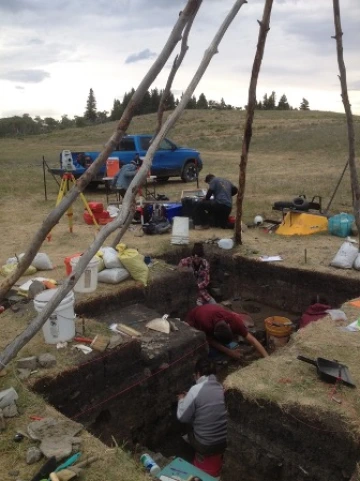
BARA and Blackfeet THPO crew excavating the Billy Big Spring site
BARA has worked since 2014 with the Piikani Nation of Alberta, the Kainai Nation of Alberta, and the Blackfeet Tribe of Montana (all part of the Blackfoot Confederacy) to document the antiquity of their presence in their ancestral territory.
This research has involved archaeological, ethnographic, cartographic, and genomic components. These multiple lines of evidence help bolster Blackfoot territorial claims in the face of encroachment by other political entities.
In collaboration with Ripan Malhi of the University of Illinois, BARA showed that ancestral and modern Blackfoot are part of a distinct genomic lineage that separated from other Native Americans during the Ice Age, and probably in the area of the Blackfoot ancestral territory. BARA used historical records of early European-Blackfoot encounters to map place names within the Blackfoot ancestral territory, showing the deep and ancient place-based knowledge of the Blackfoot.
As part of this Program, Blackfoot origin stories “Napi Stories” have been integrated with scientific domains such as archaeology, paleoecology, geology, historical linguistics, and genomics. BARA has conducted archaeological surveys and excavations that document the long-time use of the Blackfoot territory since the Ice Age.
Recently we have excavated the Billy Big Spring Site, in the foothills of the Rocky Mountains, that show persistent occupation for the last 12,000 years. This includes times of drastic environmental disturbance such as the Early Holocene Thermal Maximum (ca. 11,000-7000 years ago) and the ash fall from the Mazama Eruption (7600 years ago), when much of the Northern Plains were seemingly depopulated.
Location: Montana and Alberta
Funded By: National Science Foundation, Montana Department of Transportation
Related People or Collaborators
- Blackfeet Tribal Historic Preservation Office
- Piikani First Nation
- Kainai First Nation

